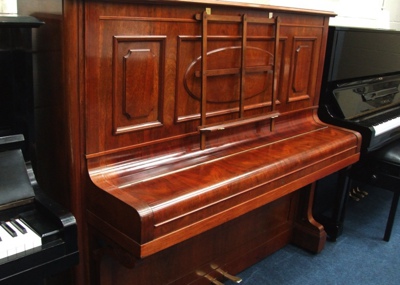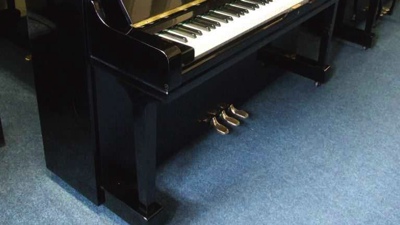Piano Advice
Grand or upright?
If you aren’t limited by space then all professional musicians will recommend buying the longest grand piano possible. This is because grand piano actions have the best control and long pianos have a deeper, richer tone. For more information about this please search “grand piano” on our video channel.
If you are unable to fit in a grand piano then the next best choice is as tall an upright as possible. This will have a larger action and longer strings.
Is a silent piano a good idea?
These allow you to play or practice without others hearing. However the silent mechanism usually interferes with the action of the piano, making soft playing more difficult, so unless you need this facility then it’s best not to have it. If there are occasions when you want to be less intrusive then many pianos have practice pedals or can have a practice lever fitted. These put a felt between the hammer and the strings, so when you play it is a lot softer.
New or used?
Less than 10,000 new pianos are sold in the UK annually and well over 100,000 pianos change hands each year (2013). Only a small percentage of new pianos are made to a good standard – especially when looking at the lower ranges. Many upright pianos from the Far East which generally retail for under £3000, are in our opinion of really unacceptable quality. Having a brash or uneven tone, unstable tuning, a gradual development of problems in the action after just a few years of use.
The new Yamaha GB1 baby grand piano, for instance, is in our opinion badly designed and we recommend paying the extra for a C1, or buying a Kawai or Feurich, or opting for a reconditioned baby grand from the 1920s or 30s.
VIDEOS (for over 100 on various themes, please see our channel)
Essential knowledge
Unlike your car, computer or digital piano, a real quality piano will be as good (and possibly better, as most new hammers take time to settle) in 10 years time as it is today, based on normal 1 hour’s use per day. After 20 years it will need light adjustment and toning of the hammers by a qualified tuner. In 50 years it will probably need two or three days’ reconditioning and possibly new hammers and bass strings. During all this time it is highly unlikely to go wrong at all. Older pianos sometimes carried lifetime guarantees! There are over 3 million pianos in the UK. Therefore the number of used pianos sold in the UK far outweighs the number of new pianos sold, which is around 10,000 per year.
Quality of manufacturing at the start of the 1900s
In the early 1900s, when most households had a piano, the industry was much larger, competition was fierce, and the quality of good pianos for sale was extremely high. It follows that a good reconditioned piano from a top maker in the early 1900s is likely to be much better than a cheap new one. Also, the ‘modern’ piano dating from about 1960 to 1980 was generally better made than an equivalent new piano made today, as more skilled technicians were in the piano manufacturing trade in those days.
Buying guide
The make is the key
By far the most important factor when buying a piano is the make. Yamaha pianos are the most prolific make and the majority of these are well made – particularly those from the 60s to 80s. However, most new Yamaha pianos for sale are no longer made in Japan and can be far inferior and in some cases unacceptable in the opinion of many tuners. We now stock a range of new Feurich grands and uprights, which we consider to be an excellent alternative to the used Yamaha G and C series grands and upright U1 and U3 pianos made in the 60s to 80s. We are extremely selective with regard to the makes and origin of pianos we take into stock. For examples and photographs of these and other good makes please see our stocklist. Our common piano makes in the UK page has a list of all the common makes available and a rating range of each make.
Height/Length
Assuming the make of piano is good, the bigger pianos have a deeper and better tone and more responsive touch. Grand pianos are generally better than uprights as the grand action lifts the hammer to the very last minute giving maximum control whereas the upright action lifts and throws it towards the string. However top quality uprights can also be very sensitive, and very small grand actions can be quite basic (see grand and upright pages for more information).
Humidity – Very Important
If you live in a dry modern house, then you may need a humidifier. This will depend largely on the make and type of piano. Good makes are more resistant to changes in humidity. As a guide, try to keep the humidity between 45% and 70% and the temperature at no more than 21°C. Under floor heating can also ruin a piano if serious steps are not taken to compensate for it.
The Tone
Good older pianos generally sound more mellow and modern ones more crisp, though there are many exceptions to this. Classical musicians often prefer a mellow tone while jazz musicians a ‘cleaner’ modern sound. It’s down to personal taste; our advice is to try as many pianos as possible before purchasing. If you’re not confident to do this, take a good teacher or tuner with you when you shop. If this isn’t possible then we also have several staff who can demonstrate the pianos for you.
Touch Weight
Touch weight is to some extent a matter of personal preference, but a piano with too heavy a touch can be difficult to play expressively. On the other hand, too light a touch is not good for serious beginners as they will not develop sufficient finger strength, though a light touch is often preferable for occasional or older players. New pianos tend to be on the heavy side while some older ones (e.g. Blüthner patent action grands) have deliberately light touch.
Piano Stools
It’s important to have the right height of stool to suit the piano and player. Please see our piano stools page.
Leg room
Leg room on pianos varies from 60 to 70cm . Grands and small modern uprights are usually about 62cm from the floor to the under side of the keyboard. With grands, this can be increased by about 3cm by using glass caster cups; the angle of the pedals may then need adapting as these are raised up too. A Yamaha U3 upright has leg room of 62cm whereas a German Steingraeber 118 has 70cm and an older Bluthner 65cm. A small modern Zender has only 58.5cm!
Important advice
We advise you never to buy a piano without getting a technician/tuner to assess it. Choose a PTA (Piano Tuners Association) member. The charge should be modest, and could well save you hundreds of pounds! Thank you for reading this. If you’ve followed these principles, then your well chosen piano will bring life into your home for generations to come!


